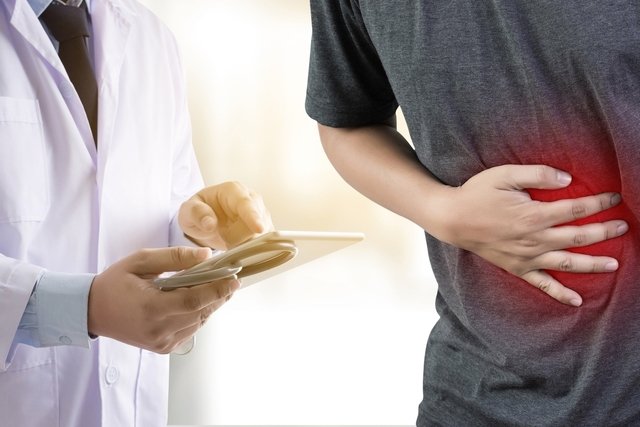Pancreatitis is inflammation of the pancreas that causes the digestive enzymes produced by this organ to become more active, promoting progressive destruction of pancreas tissue. Thus, due to inflammation, signs and symptoms such as abdominal pain, nausea, vomiting, fever and hypotension can be noticed.
The development of pancreatitis can be favored by excessive consumption of alcoholic beverages, the presence of gallstones, viral infections, autoimmune changes or be a consequence of the use of some medications.
In the presence of signs and symptoms of pancreatitis, it is important that the doctor is consulted so that the diagnosis can be made and the most appropriate treatment can be initiated, which can be done through the use of medication or surgery.

Main symptoms
The main symptoms of pancreatitis are:
- Pain in the upper part of the abdomen, which may radiate to the back, which worsens over time and after meals;
- Nausea and vomiting;
- Swelling and tenderness in the belly;
- Fever;
- Increased heart rate;
- Yellow or white stools with signs of fat;
- Unintentional weight loss;
- Malnutrition, as digestion is not complete and nutrients cannot be absorbed by the intestine.
It is important that the doctor is consulted as soon as the first symptoms appear so that treatment can be started immediately and thus prevent complications, such as bleeding and serious changes in the kidneys, lungs and heart, which can be life-threatening.
Don’t ignore the signs your body is giving you!
Types of pancreatitis
According to the duration and evolution of symptoms, pancreatitis can be classified into two main types:
- Acute: it happens suddenly and lasts relatively short;
- Chronicle: Symptoms worsen over time, potentially causing permanent damage and making treatment more complex.
It is important that the type of pancreatitis is identified so that the best treatment can be initiated and, thus, complications can be prevented.
How the diagnosis is made
The diagnosis of pancreatitis must be made by a gastroenterologist or general practitioner through the evaluation of signs and symptoms, in addition to tests that allow the pancreas to be evaluated and the cause of the inflammation identified.
Thus, the doctor may recommend imaging and laboratory tests, especially the measurement of amylase and lipase enzymes in the blood, which are enzymes produced by the pancreas. Understand how pancreatitis is diagnosed.
Possible causes
Pancreatitis is caused by situations that can interfere with the functioning of the pancreas and alter the process of production and release of digestive enzymes.
Although it can occur in healthy people, pancreatitis is more common in some cases, such as:
- Excessive consumption of alcoholic beverages;
- Gall stones;
- Cystic fibrosis;
- Autoimmune diseases.
- High levels of calcium in the blood;
- Pancreatic cancer;
- As a consequence of the use of any medication;
- Viral infections, such as mumps or measles.
Furthermore, people with a family history of pancreatitis are also more likely to have the problem at some point in their lives.
How the treatment is carried out
Treatment for pancreatitis is carried out in the hospital and varies according to the symptoms presented by the person and the severity of the disease, and the use of medications to relieve pain and the use of antibiotics may be indicated, in some cases, to reduce the risk of infections. secondary.
Furthermore, in the case of acute pancreatitis, it is recommended that the person does not eat until the crisis has passed, as this will prevent inflammation of the pancreas and promote its recovery.
In the case of chronic pancreatitis, tube feeding may be necessary for a few weeks, and the doctor may recommend the use of medicines with digestive enzymes, which help digest food and allow it to be absorbed by the intestine. See more details about the treatment of pancreatitis.
Check out the video below for more tips on eating for pancreatitis:
Bibliography
- Fernando Manuel Veigas de Carvalho. Pancreatite aguda (Acute pancreatitis). Monograph for the Integrated Masters in Medicine, 2017. University of Porto.
- Longo, DL et al. Harrison’s Principles of Internal Medicine. 19.ed. New York: McGraw-Hill, 2015.
- NHS. Acute pancreatitis. Available at: <https://www.nhs.uk/conditions/acute-pancreatitis/>. Accessed on May 4, 2020
- NATIONAL INSTITUTE OF DIABETES AND DIGESTIVE AND KIDNEY DISEASES. Pancreatitis. Available at: <https://www.niddk.nih.gov/health-information/digestive-diseases/pancreatitis>. Accessed on May 4, 2020

Sign up for our newsletter and stay up to date with exclusive news
that can transform your routine!
Warning: Undefined array key "title" in /home/storelat/public_html/wp-content/plugins/link-whisper-premium/templates/frontend/related-posts.php on line 12
Warning: Undefined array key "title_tag" in /home/storelat/public_html/wp-content/plugins/link-whisper-premium/templates/frontend/related-posts.php on line 13




